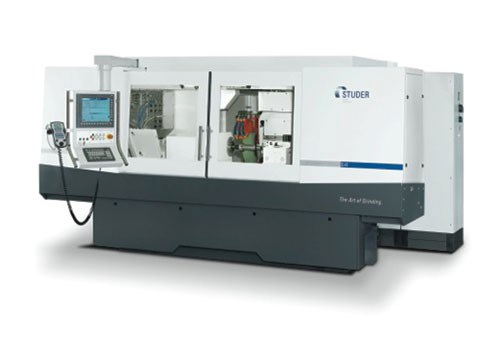One Hundred Years of Grinding Advances
With one hundred years’ experience, Studer is one of the best known brands in precision cylindrical grinding.
In 1912, Fritz Studer established a small machine shop in Steffisburg, Switzerland. Because he had no grinding machine to produce precise parts, he promptly built his own. Thus Studer AG was born, a company still dedicated to supplying complex grinding solutions and processes. One of the earliest Studer designs is on display at United Grinding, Booth N-6800. Of course, the latest Studer grinders such as the S41 CNC universal cylindrical grinder are also on display.
Today, the company is the largest employer in the Thun region of Switzerland. With one hundred years’ experience, Studer is one of the best known brands in precision cylindrical grinding. Some 800 employees, 95 percent of whose work is exported from the company headquarters, are responsible for this success. The technical specialists in the head office are supported by more than 300 representatives in 40 countries.
In February 1912, with no assured work prospects and no manufacturing program, the young Fritz Studer (age 33) patented a noiseless reversing table as his first invention. After the difficult times of World War I, the one-man company was converted into a corporation. Success followed with the improvement in the economic situation.
At the beginning of the 30s, the workforce had increased to 36 employees. Despite the continuing economic crisis, the company produced 38 machines a year. This is due, not least, to large orders from Russia, where the first machine to be exported was delivered in 1931. These were the first successes of Alfred Studer, who had joined the company in 1929. In addition to planning expansions, he concentrated on developing a worldwide sales organization. After various building expansion stages in 1944, 1945 and 1956, the factory area had reached a size of 10,000 square meters in 1962. Since then the company has regularly expanded, due to developments in the production and manufacturing methods.
To test the market, Dr. Marc Studer, from the third Studer generation, presented machines finished in Bordeaux red and white at several exhibitions. Following positive customer reaction, the decision was made to introduce this distinctive coloring in 1985. The thinking was that the machines of Fritz Studer AG should not only be better than those of the competition, but also more beautiful. The range of different machine types became ever broader: from conventional cylindrical grinding machines through to CNC cylindrical grinding machines for small to medium-sized workpieces.
Single-purpose machines with optimized grinding cycles were added to the range for large-batch production, as well as a combined machine tool for process optimization and internal cylindrical grinding, with up to four internal grinding spindles. In the first hundred years of the company’s history, Studer has delivered more than 21,000 cylindrical grinding machines around the world.
Structural problems in European machine tool manufacturers at the beginning of the 1990s made mergers and acquisitions inevitable. Since spring 1994, Fritz Studer AG has been part of the Körber-Schleifring Group, which includes companies in tool grinding, profile grinding and cylindrical grinding, with brands such as Schaudt, Mikrosa and Walter. United Grinding is the U.S arm of this organization.
Focusing on the future of cylindrical grinding, the Studer S41CNC universal cylindrical is representative of the company’s advanced technology. This machine has a rigid and thermally stable Granitan composite machine bed that equalizes brief variations in temperature. The guideways of the longitudinal slide and cross-slide are molded directly into the machine bed, and are moved by a linear direct drive as fast as 66 fpm. The company guarantees a straightness of <0.0001 inch over a measured length of 37.4000 inches.
The standard height of centers is 8.9 inches and the maximum distance between centers is 39.4 inches. The machine is capable of handling workpieces weighing as much as 551 lbs. It can be equipped with as many as four external grinding wheels driven by motor spindles, or three internal grinding spindles, enabling more than 30 grinding head combinations. Internal grinding spindles with speeds from 6,000 to 120,000 rpm can be used. The Fanuc 31i-A machine control with integrated PC and 15-inch touchscreen uses StuderGrind software and StuderWin as operator interfaces.
Read Next
The Cut Scene: The Finer Details of Large-Format Machining
Small details and features can have an outsized impact on large parts, such as Barbco’s collapsible utility drill head.
Read More3 Mistakes That Cause CNC Programs to Fail
Despite enhancements to manufacturing technology, there are still issues today that can cause programs to fail. These failures can cause lost time, scrapped parts, damaged machines and even injured operators.
Read More














.png;maxWidth=300;quality=90)








